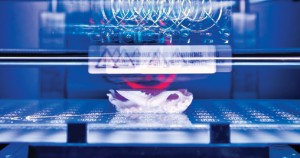 By Linda Terhune
By Linda Terhune
Technology analysts are predicting a 3-D printing revolution in the near future that could rival the Internet revolution in its impact. College of Technology researchers in two departments are taking part in that revolution with efforts to make the printers and their products better.
"Imagine you are a hobbyist and you have a vintage train model. Parts are no longer being manufactured, but their specifications can be downloaded from the Internet, and you can generate them using a 3-D printer," says Bedrich Benes, associate professor of computer graphics technology (CGT).
The 3-D additive printers create shapes layer-by-layer out of various materials, including metals and plastic polymers. Industry has used 3-D printing in rapid prototyping for about 15 years, but recent innovations have made the technology practical for broader applications, Benes says.
There is a challenge, however. Objects created using current 3-D printing can be fragile and often fall apart when exposed to stress, or they can lose their shape. Benes and his graduate students researchers are addressing these issues.
The High Performance Computer Graphics Lab creates software systems related to computer graphics and 3-D objects. They can evaluate and test a 3-D model before it is created using additive manufacturing. “The interesting part for us is that we try to fix them in such a way that it alters the shape of the model in a minimal way. It is essentially a mathematical optimization problem,” Benes says.
Former Purdue doctoral student Ondrej Stava, now a computer scientist at Adobe, created a software application that automatically strengthens objects either by increasing the thickness of key structural elements or by adding struts. The tool can also reduce the stress on structural elements by hollowing out overweight elements. The new tool automatically identifies "grip positions" where a person is likely to grasp the object.
Henry Zhang, assistant professor of mechanical engineering technology (MET), is studying 3-D printing from another perspective. His research group designs and builds 3-D printers and writes programs for them. In his Multidisciplinary Design Laboratory, the newly designed printers have more friendly features for precision control and performance.
Zhang’s MET colleague Mark French is fascinated with the potential of the printing technology and is working to integrate it into the curriculum.
“When we are able to make 3-D printing a routine part of what our students do, the division between design and manufacture fades,” French says. “For now, we are pretty much limited to making objects with plastic, but that will change. Our students will have design latitude that I couldn't have imagined when I was in college. Very cool.”
(Photo: A CoT 3D printer captured in motion, printing a dragon model.)
